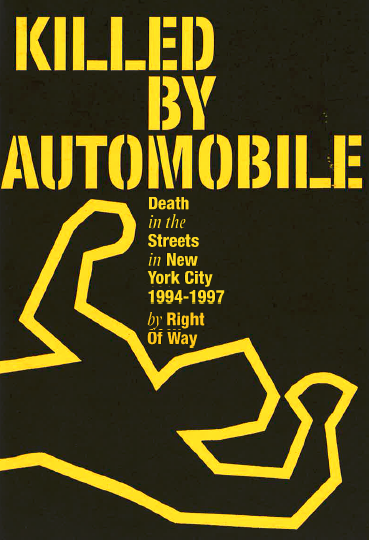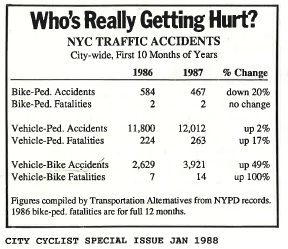Amid the bloodiest year in Mayor de Blasio’s Vision Zero, Streetsblog continues its seven-part series focusing on a key strand in the movement for livable safe streets, written by a central figure in that movement, Charles Komanoff. A former head of Transportation Alternatives, Komanoff 25 years ago launched a highly effective public awareness campaign calling out the daily carnage on New York City streets. Under the name “Right Of Way,” his group brought the brutal reality of pedestrian and cyclist deaths to the public eye in the form of high-visibility street actions (including one arrest). Part I last Monday opened with the first "Killed by Automobile" stenciling in December 1996. Part II on Wednesday focused on how the movement began to generate press coverage. Part III on Friday looked at how the movement branched out.

What most astonishes today about “Killed By Automobile,” the 64-page booklet Right Of Way published more than two decades ago, is how much baseless conventional wisdom it shattered about traffic dangers.
Subtitled “Death in the Streets in New York City 1994-1997” and released in March 1999, “Killed By Automobile” documented and deconstructed what we termed “the ongoing slaughter of pedestrians and cyclists on New York City’s streets” during the mid-1990s and, by implication, throughout a century of surrender to automobility.

Our framing, our findings — the entire endeavor — were transgressive. No one in or out of government had ever collected and sifted through pedestrian and cyclist deaths in New York or any other U.S. city. No one had ever reported in comprehensive fashion who was being killed and who was doing the killing. Perhaps most crucially, no one had tried to find patterns revealing how pedestrian killings were taking place and who was at fault.
“Killed By Automobile” broke new ground on every page, whether establishing the genuine dimensions of the carnage, anatomizing the windshield mindset of complicit police and public officials, or offering an agenda for safe design and governance of our streets.
We didn’t feign neutrality. A glance at our white-hot thumbnails of four emblematic driver-caused fatalities — of Alberta Kenney and Rachel Fruchter (see Part II of this series), Michael Regina, and Aaron Brown (upcoming in Part V) — made clear where our sympathies lay. Nevertheless, every finding rested squarely on our meticulous data handling and fastidious reconstruction of hundreds of deadly crashes.
The book’s central finding, “Drivers are at fault in most pedestrian deaths,” could be seen in the New York Times’ headline of its story on our report. The headline was a long time coming. We had fought for this framing for more than a decade, even publishing an essay in the caustically anti-NYT ’zine Lies Of Our Times decrying the paper’s unceasing whitewashing of vehicular butchery.
"Killed By Automobile,” by establishing driver fault as the fundamental fact of traffic danger, carried forward, on a larger and more comprehensive scale, our work deflating the moral panic over bicycles in the late 1980s, as in tables such as the one at right from Transportation Alternatives' City Cyclist ’zine. "Killed By Automobile” made undeniable that, at least in New York City, the unending onslaught of pedestrian injury and death is due primarily to driver misconduct.
The investment of time to review each case required that we limit our causal analysis to one year’s fatalities, 1997. Even so, our sample, 242 pedestrian and cyclist fatalities, was large and the findings were clear:
- In 58 percent of the fatalities, the pedestrian or cyclist had a clearly established right of way, making the driver unequivocally to blame. (See donut chart right.)
- In an additional 13 percent of cases, a driver infraction contributed to the fatal collision. Combining this with the prior category meant that drivers bore fault in at least 71 percent of New York City pedestrian and bicyclist fatalities in 1997, as shown in the light and dark blue donut segments.
- There were 53 fatalities, 22 percent, for which we were unable to affix culpability, “either because the police report was incomplete or inconsistent,” as the Times put it, “or because there was no witness to support a driver’s claim that the accident [sic] was the pedestrian’s fault.” Setting those aside, drivers were at least partly culpable in 90 percent of crashes (171 out of 189) that killed pedestrians or cyclists.
- We deemed the pedestrian or cyclist solely responsible in the remaining 18 crashes, accounting for just 7 percent of the total and barely 10 percent of those for which we were able to assign responsibility.
"Killed By Automobile” also drew on all 947 fatal crash reports furnished by the Department of Motor Vehicles, which corresponded to 1,020 total pedestrian and cyclist fatalities from 1994 through 1997. Our many statistical takeaways included these gut-punchers:
- New Yorkers age 65 and above were more than twice as likely to be killed by a driver as to be murdered. For the oldest New Yorkers, 85 and over, deaths by auto outnumbered murders more than four to one.
- Motorists killed 50 pedestrians on sidewalks during 1994-97; during the same period, just one pedestrian was killed by a bicycle on a sidewalk.
- The number one cause of pedestrian fatalities was vehicles turning into people in crosswalks; next was driver speeding and driving through a red light or stop sign.
- Ninety-one percent of drivers who killed were men — a grossly disproportionate rate even adjusting for the preponderance of male drivers overall, which we estimated was 75 percent.
- The NYPD issued moving violations to drivers in only 154 of the 1994-97 fatalities, or just 16 percent of the 947 cases in our database.
(Somewhat to our surprise, the data did not point to disproportionately high killing rates of pedestrians in low-income areas and/or communities of color. Rather, drivers appeared to be killing New Yorkers of every income level and racial or ethnic group roughly in proportion to each group’s share of overall population; as we put it in "Killed By Automobile,” motor vehicles were equal-opportunity killers, at least in the time and place covered in the report.)
As with most reports, the payoff from “Killed By Automobile” is hard to measure. We certainly won over the New York Times. The paper’s solid coverage of our release, in March 1999, was followed in April by Walking? Beware the Male Driver, an article reporting the gross over-representation of men among killer-drivers. Also important was a shift in the paper’s tone; gone, for the most part, was the supercilious, bemused stance regarding pedestrian imperilment as built into urban life or, worse, deserved.
Perhaps no one in New York was more affected by "Killed By Automobile” than Bette Dewing, the Upper East Side activist who helped set public opinion against bicycles in the 1980s, as noted in Part II. We presented Dewing with a copy, of course, and in ensuing years eagerly answered her entreaties for more copies to replace those she pressed into the hands of neighbors, elected officials and police. While Dewing never quite became pro-bike, the anti-car harangues in her Our Town newspaper columns set a new tone.
The one-two punch of our memorial stenciling and our “Killed By Automobile" booklet sidelined most anti-bike sentiment. It also appeared to destine Right Of Way to lead new, audacious campaigns for safer streets. Life had other plans.
This series will return on Wednesday with Part V. To read prior stories, start with Part I, and follow the links.








